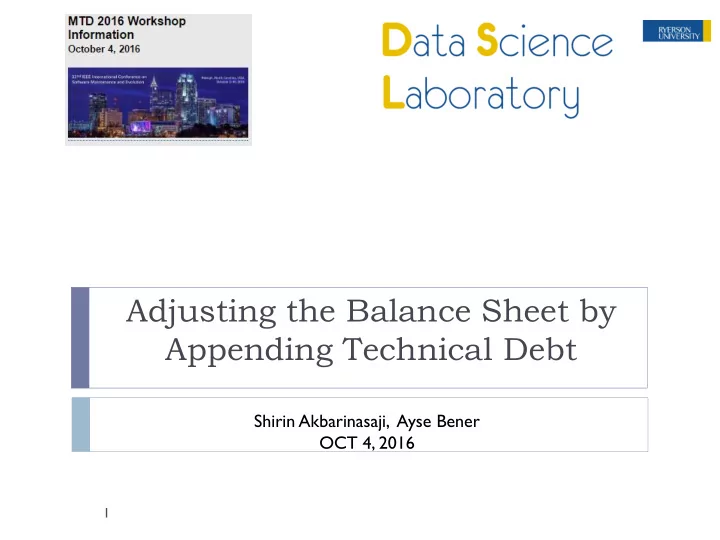

Adjusting the Balance Sheet by Appending Technical Debt Shirin Akbarinasaji, Ayse Bener OCT 4, 2016 1
Outline Motivation Research Question Balance Sheet Adjusted Balance Sheet What would be the effect of adding TD liability in the balance sheet? Discussion and Conclusion 2
Motivation Current state of art: • Identifying technical debt • Justifying what to include and what to exclude in the technical debt scope • How to deal with them: either to defer the development activity or to avoid debt Gap: • There are only a few studies which considered technical debt as a financial obligation 3
Motivation Multidisciplinary nature of Technical debt Software engineering processes Financial theory. Software practitioners are interested in architecture, requirement, source code and refactoring. Project managers would like to hear about value, cost, benefit, debt, and etc. Consequently, considering the technical debt strictly as software engineering processes put the enterprise at risk of not properly managing the interest of stakeholders. 4
Technical deb financial schema A. Ampatzoglou et al. “The financial aspect of managing technical debt: A systematic literature review ,” Information and Software Technology, vol. 64, pp. 52 – 73, 2015.
Problem Statement RQ: How to adjust the balance sheet by appending/ including technical debt items? 6
Balance Sheet Balance sheet is a report of financial position of the company at a particular point in time: Total Assets = Total Liability + Equity Asset is any ownership of the organization which is convertible to money. Current assets: Cash, Marketable securities, Short term investments,Accounts receivables, Inventory, Prepaid expenses Non-current assets: Property, plant, equipment, Investment property, Intangible asset, Goodwill 7
Balance Sheet Liabilities are defined as “the future sacrifices of economic benefits that the entity is presently obliged to make to other entities as a result of past transactions or other past events.” Current liabilities: Accounts Payable, Accrued Expenses, Notes Payable, Short T erm Debt, Income taxes payable, Unearned revenue Long-term liabilities: long-term bonds, notes payable, long-term leases, long-term product warranties, Deferred income tax, Provision An equity is defined as net assets or the residual of assets after reduction of liabilities. 8
Adjusted Balance Sheet 9
A glossary of financial terminology TD current liability: The liability associated with TD item which should be fixed before the next release of a product. TD accounts payable: Accounts related to software artifact that we shipped with a TD item. The software organization owes to fix those TD items for its customers. TD Notes payable: A commitment/obligation for enhancement or adding features in the future Short term TD: Software artifact that is postponed but needs to be accomplished as soon as possible TD Non-current liability: The liability associated with TD that is possible to be postponed to the next release with small to zero effect on the development activity now but it has long term consequences. TD provision: An example of the provision is TD interest that the team is not sure about the expense but they need to put aside some money for their associated cost. Deferred TD: Advance payment for software that is not delivered / not shipped 10
What would be the effect of adding TD liability in the balance sheet? More realistic insight about the liabilities of the corporation. Better prioritize liabilities in general and technical debt liabilities in particular Make a better decision making whether to improve the business profits or to go into more investment Neglecting technical debt as a liability might cause to misinterpret financial ratios: Liquidity ratio: Cash Ratio, Current Ratio, Acid T est Ratio Debt ratio: Debt ratio, Debt T o Equity Ratio 11
Discussion & Conclusion All the technical debt associated with the product(s) should be extracted by a technical specialists. They should estimate and quantify technical debt value. Technical debt can also be assumed as form of intangible liabilities. software corporations with the aid of International Accounting Standards (IAS) require developing an official protocol for monetizing the technical debt. We will investigate the implication of TD in other financial statement for future study. 12
Thank You ! www.datasciencelab.ca shirin. akbarinasaji@ryerson.ca ayse.bener@ryerson.ca 13
Recommend
More recommend